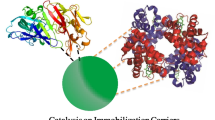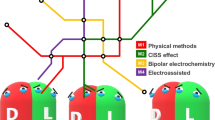Abstract
(R)-2-Phenoxy-propionic acid methyl ester (PPAM) is an important chiral precursor of aryloxy phenoxy propionate herbicides. The covalent immobilization of lipase from Aspergillus oryzae WZ007 and the catalysis of enantioselective (R, S)-PPAM resolution by the immobilized A. oryzae lipase (AOL) were investigated in this study. The primary amino resin LX-1000HA was selected as the support for the covalent immobilization of AOL. The Km and Vmax of the immobilized lipase were 1.97 mM and 4.84 × 103 μmol/mg min, respectively. The key reaction parameters (pH, temperature, rotation speed, and substrate concentration) for the lipase-catalyzed resolution of (R, S)-PPAM were optimized. An e.e.s of 99.5% and conversion rate of 50.8% were achieved under the optimal conditions of pH 7.5, 30 °C, and substrate concentration 500 mM. The immobilized lipase retained 87.3% of its initial activity after 15 cycles of the repeated experiments. The results demonstrated that the covalent immobilized AOL has potential industrial applications.








Similar content being viewed by others
References
Singh, A. K., & Mukhopadhyay, M. (2012). Overview of fungal lipase: a review. Applied Biochemistry and Biotechnology, 166(2), 486–520.
Facin, B. R., Valério, A., Bresolin, D., Centenaro, G., de Oliveira, D., & Oliveira, J. V. (2018). Improving reuse cycles of Thermomyces lanuginosus lipase (NS-40116) by immobilization in flexible polyurethane. Biocatalysis and Biotransformation, 36(5), 1–9.
Oliveira, P. C. D., Alves, G. M., & Castro, H. F. D. (2000). Immobilisation studies and catalytic properties of microbial lipase onto styrene-divinylbenzene copolymer. Biochemical Engineering Journal, 5(1), 63–71.
Kanmani, P., Aravind, J., & Kumaresan, K. (2015). An insight into microbial lipases and their environmental facet. International journal of Environmental Science and Technology, 12, 1147–1162.
González-Sabı́n, J., Gotor, V., & Rebolledo, F. (2004). Kinetic resolution of (±)-trans- and (±) -cis-2-phenylcyclopentanamine by CALB-catalyzed aminolysis of esters: the key role of the leaving group. Tetrahedron: Asymmetry, 15(3), 481–488.
Hasan, F., Shah, A. A., & Hameed, A. (2006). Industrial applications of microbial lipases. Enzyme and Microbial Technology, 39(2), 235–251.
Cui, Y., Chen, X., Li, Y., Liu, X., Lei, L., Zhang, Y., & Qian, J. Y. (2014). Superparamagnetic polymer emulsion particles from a soap-free seeded emulsion polymerization and their application for lipase immobilization. Applied Biochemistry and Biotechnology, 172(2), 701–712.
Bancerz, R. (2017). Industrial application of lipases. Postepy Biochemii, 63(4), 335–341.
Zhang, K., Pan, Z., Diao, Z., Liang, S., Han, S., Zheng, S., & Zhang, K. (2018). Kinetic resolution of sec-alcohols catalysed by Candida antarctica lipase B displaying Pichia pastoris whole-cell biocatalyst. Enzyme and Microbial Technology, 110, 8–13.
Zhang, C., Dong, X., Guo, Z., & Sun, Y. (2018). Remarkably enhanced activity and substrate affinity of lipase covalently bonded on zwitterionic polymer-grafted silica nanoparticles. Journal of Colloid and Interface Science, 519, 145–153.
Homaei, A. A., Sariri, R., Vianello, F., & Stevanato, R. (2013). Enzyme immobilization: an update. Journal of Chemical Biology, 4, 185–205.
Mehdi, M., Zohreh, H., & Somayyeh, G. (2018). A novel approach for bioconjugation of Rhizomucor miehei lipase (RML) onto amine-functionalized supports; application for enantioselective resolution of rac-ibuprofen. International Journal of Biological Macromolecules, 117, 523–531.
Mehrasbi, M. R., Mohammadi, J., Peyda, M., & Mohammadi, M. (2017). Covalent immobilization of Candida antarctica lipase on core-shell magnetic nanoparticles for production of biodiesel from waste cooking oil. Renewable Energy, 101, 593–602.
Indu, B., Rashmi, S., Pankaj, G., & Bhahwal, A. S. (2018). Enantioselective resolution of 2-arylpropionic acid derivatives employing immobilization of lipase from Bacillus subtilis strain Kakrayal_1 (BSK-L). Bioresource Technology, 269, 581–585.
Hauser, M., Qian, C., King, S. T., Kauffman, S., Naider, F., Hettich, R. L., & Becker, J. M. (2017). Identification of peptide-binding sites within BSA using rapid, laser-induced covalent cross-linking combined with high-performance mass spectrometry. Journal of Molecular Recognition, 31(2), e2680.
Kinne, M., Ullrich, R., Hammel, K. E., Scheibner, K., & Hofrichter, M. (2008). Regioselective preparation of (R)-2-(4-hydroxyphenoxy) propionic acid with a fungal peroxygenase. Tetrahedron Letters, 499, 5950–5953.
Yasufuku, Y., & Ueji, S. I. (1997). High temperature-induced high enantioselectivity of lipase for esterifications of 2-phenoxypropionic acids in organic solvent. Bioorganic Chemistry, 25(2), 88–99.
Zheng, J. Y., Wu, J. Y., Zhang, Y. J., & Wang, Z. (2013). Resolution of (R, S)-ethyl-2- (4-hydroxyphenoxy) propanoate using lyophilized mycelium of Aspergillus oryzae WZ007. Journal of Molecular Catalysis B: Enzymatic, 97, 62–66.
Zheng, J. Y., Lan, X., Li, X. J., Huang, L. J., Zhang, Y. J., & Wang, Z. (2018). High-level expression and characterization of a stereoselective lipase from Aspergillus oryzae in Pichia pastoris. Protein Expression and Purification, 155, 1–7.
Rakels, J. L. L., Straathof, A. J. J., & Heijnen, J. J. (1993). A simple method to determine the enantiomeric ratio in enantioselective biocatalysis. Enzyme and Microbial Technology, 15(12), 1051–1056.
Wolff, A., Zhu, L., Wong, Y. W., Straathof, A. J. J., Jongejan, J. A., & Heijnen, J. J. (1999). Understanding the influence of temperature change and cosolvent addition on conversion rate of enzymatic suspension reactions based on regime analysis. Biotechnology and Bioengineering, 62(2), 125–134.
Cipiciani, A., Bellezza, F., Fringuelli, F., & Silvestrini, M. G. (2001). Influence of pH and temperature on the enantioselectivity of propan-2-ol-treated Candida rugosa lipase in the kinetic resolution of (±)-4-acetoxy-[2, 2]-paracyclophane. Tetrahedron: Asymmetry, 12(16), 2277–2281.
Acknowledgments
This research was financially supported by the National Natural Science Foundation of China (no. 31600639, no. 31660247) and the Education Department of Jiangxi Province (GJJ151211).
Author information
Authors and Affiliations
Corresponding author
Ethics declarations
Conflict of Interest
The authors declare that they have no conflicts of interest.
Additional information
Publisher’s Note
Springer Nature remains neutral with regard to jurisdictional claims in published maps and institutional affiliations.
Electronic Supplementary Material
E-supplementary data of this work can be found in online version of the paper, at https://doi.org/10.1016/.2019.00.000.
ESM 1
(DOCX 103 kb)
Rights and permissions
About this article
Cite this article
Zhong, W., Zhang, M., Li, X. et al. Enantioselective Resolution of (R, S)-2-Phenoxy-Propionic Acid Methyl Ester by Covalent Immobilized Lipase from Aspergillus oryzae. Appl Biochem Biotechnol 190, 1049–1059 (2020). https://doi.org/10.1007/s12010-019-03145-4
Received:
Accepted:
Published:
Issue Date:
DOI: https://doi.org/10.1007/s12010-019-03145-4




